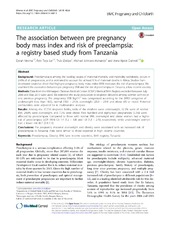| dc.contributor.author | Mrema, Dorah Elisonguo | en_US |
| dc.contributor.author | Lie, Rolv T. | en_US |
| dc.contributor.author | Østbye, Truls | en_US |
| dc.contributor.author | Daltveit, Anne Kjersti | en_US |
| dc.contributor.author | Mahande, Michael Johnson | en_US |
| dc.date.accessioned | 2019-01-08T14:27:56Z | |
| dc.date.available | 2019-01-08T14:27:56Z | |
| dc.date.issued | 2018-02-21 | |
| dc.Published | Mrema DE, Lie RT, Østbye T, Daltveit AK, Mahande M. The association between pre pregnancy body mass index and risk of preeclampsia: a registry based study from Tanzania. BMC Pregnancy and Childbirth. 2018;18:56 | eng |
| dc.identifier.issn | 1471-2393 | |
| dc.identifier.uri | https://hdl.handle.net/1956/18857 | |
| dc.description.abstract | Background: Preeclampsia is among the leading causes of maternal mortality and morbidity worldwide, occurs in 2-8% of all pregnancies, and is estimated to account for at least 9 % of maternal deaths in Africa. Studies from developed countries show that high pre pregnancy body mass index (BMI) increases the risk of preeclampsia. We examined the association between pre pregnancy BMI and the risk of preeclampsia in Tanzania, a low income country. Methods: Data from the Kilimanjaro Christian Medical Center (KCMC) Medical Birth Registry recorded between July 2000 and May 2013 were used. We restricted the study population to singleton deliveries among women with no or one previous pregnancy. Pre pregnancy BMI (kg/m2) was categorized according to the WHO categories of underweight (less than 18.5), normal (18.5 – 24.9), overweight (25.0 – 29.9) and obese (30 or more). Potential confounders were adjusted for in multivariable analyses. Results: Among the 17,738 singleton births, 6.6% of the mothers were underweight, 62.1% were of normal BMI, 24.0% were overweight, and 7.3% were obese. Five hundred and eighty-two pregnancies (3.3%) were affected by preeclampsia. Compared to those with normal BMI, overweight and obese women had a higher risk of preeclampsia (aOR (95% CI) 1.4 (1.2 – 1.8) and 1.8 (1.3 – 2.4)), respectively, while underweight women had a lower risk (0.7 (0.4-1.1)). Conclusions: Pre pregnancy maternal overweight and obesity were associated with an increased risk of preeclampsia in Tanzania. Risks were similar to those reported in high income countries. | en_US |
| dc.language.iso | eng | eng |
| dc.publisher | BioMed Central | eng |
| dc.relation.uri | https://bmcpregnancychildbirth.biomedcentral.com/track/pdf/10.1186/s12884-018-1687-3 | |
| dc.rights | Attribution CC BY | eng |
| dc.rights.uri | http://creativecommons.org/licenses/by/4.0 | eng |
| dc.subject | Preeclampsia | eng |
| dc.subject | Obesity | eng |
| dc.subject | BMI | eng |
| dc.subject | Low income countries | eng |
| dc.subject | Birth registry | eng |
| dc.subject | Tanzania | eng |
| dc.title | The association between pre pregnancy body mass index and risk of preeclampsia: a registry based study from Tanzania | en_US |
| dc.type | Peer reviewed | |
| dc.type | Journal article | |
| dc.date.updated | 2018-04-25T13:56:08Z | |
| dc.description.version | publishedVersion | en_US |
| dc.rights.holder | Copyright 2018 The Author(s) | |
| dc.identifier.doi | https://doi.org/10.1186/s12884-018-1687-3 | |
| dc.identifier.cristin | 1581658 | |
| dc.source.journal | BMC Pregnancy and Childbirth | |

